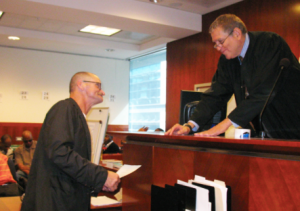Reprinted from January 2016
While running the nacent San Francisco Parole Reentry Court in 2010, I rediscovered the importance of engaging parolees in what the social scientists call “Pro-Social Activities”. If you could provide opportunities to engage in positive community-based activities (especially productive or creative ones), they were very likely to succeed. It worked for the serious and violent offenders that appeared before me. Though many believe that sanctions and especially incarceration are necessary to achieve compliance, that just wasn’t the case in our program (“San Francisco Reentry court:87% fewer return to Prison”).
Confirmation comes from many programs and studies in the U.S. and around the world. One of the most exciting is the success of the Italian Prison Theatre, which teaches and produces serious theatre, both inside and outside of prison. The following is largely taken from a 2013 article on the website of Jean Trounstine as well as a 2009 Los Angeles Times article.
“Since 1988, Compagnia della Fortezza, the company named after the Medici-era fortress that houses the Volterra jail where the men are imprisoned, has performed a variety of Italian spectacles and tragedies As a byproduct of that success, though prison conditions are generally deplorable in Italy, (which has a 65% return to prison rate similar to most of Europe), for those who engage in the Theatre Programs, it’s about 10%.
The Italians love art so much, the rumor goes, that the prisoners would rather risk an arrest than not show their performances to other Italians. Many shows tour and many prisoners work outside during the day. And believe it or not over half the 205 prisons in Italy have acting companies. Compagnia della Fortezza has won some of Italy’s most prestigious theatre awards and houses a gourmet restaurant where prisoners work and serve food to the public.
“For 21 years, director Amando Punzo has dedicated himself to art behind bars. Punzo has embarked on a challenging repertoire for the company, including “plays based on works by Brecht, Peter Handke, and even the tale of Pinocchio.” He says that it is not therapy that drives him but creating good theatre. Said Director Punzo, “It’s not about giving the inmates an outlet or a recreational break. It’s work.” The side effect of theatre programs behind bars are self-respect, community building and a love for the stage.”
The photo displayed above, is one of many in a photo essay by Clara Vannuci, an Italian photographer who has documented in amazing pictures the essence of Director Amando Punzo’s vision. Photographer Vannuci relayed how she asked a prisoner why no one tried to escape. The response reflected how much theatre has the potential to change lives: “Why should I run? Where would I go? Twenty years I’ve lived in prison. Now I have something to live for. Life has meaning.”







